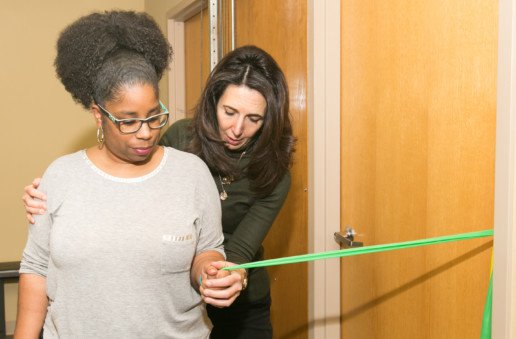
Why Can’t I Just Have The Surgery?
Being stopped in your tracks by a debilitating injury can be a frustrating time. Many times, Dr. Aribindi will enhance your care by referring you to Tina DeLuca-Caruso for physical therapy rather than surgery. Why is this a better choice – especially if you end up having the surgery anyway?
Many orthopedic issues, ranging from minor injuries to chronic diseases, can often be effectively treated with physical therapy. Arthritis and bursitis respond well to stretching and strengthening exercises as well as basic posture and body mechanics training. These techniques, along with ultrasound or electrical stimulation, can often help patients experiencing chronic joint pain avoid or postpone surgery. Patients suffering from overuse injuries respond particularly well to physical therapy, and when you adopt the strengthening and conditioning exercises you learn into everyday life, further injury can be avoided.
A 2013 New England Journal of Medicine study proved that for people experiencing osteoarthritis and/or meniscal tears, physical therapy is equally as effective as surgery. The study focused on 351 patients aged 45 years or older with these injuries, with some receiving just physical therapy and others receiving surgery first. After 6–12 months, all patients who did not choose surgery had the same or less pain and the same or more functional improvement than those who chose surgery.
Lumbar spinal stenosis, a cause of low back pain, is sometimes treated with surgery. However, an Annals of Internal Medicine study showed physical therapy works just as well, and comes with fewer unwanted complications than surgery.
Physical therapy can assist with healing, improve physical health and facilitate mobility, completely eliminating the need for surgery. When surgery is unavoidable, incorporating physical therapy into your overall treatment plan may help you postpone surgery until you are stronger and healthier. Physical therapy before surgery also makes recovery after surgery faster and easier.
Physical therapists rely on a variety of non-invasive techniques to treat their patients - from strengthening and range-of-motion exercises, to water therapy and deep tissue massage. Tina will assess your mobility, balance and strength before creating your physical therapy treatment plan.
Physical therapy is usually necessary for patients after surgery. Doing your physical therapy correctly and adhering to your recommended schedule will restore function, build up muscle strength, relieve pain, ease swelling, increase circulation and help prevent blot clots. You’ll return to normal activities, pain-free, much faster.
Immediate surgery may be the best choice with certain conditions and health challenges. However, whenever you are able, beginning with physical therapy may help you avoid surgery and its risks of complications altogether. Complete compliance with physical therapy after surgery will help you regain a pain-free active life.
Do you have questions about your physical therapy or are you looking for an alternative to immediate surgery for pain? Reply to this email, click here or call 708-283-2600 to make an appointment. Dr. Aribindi is happy to help!

